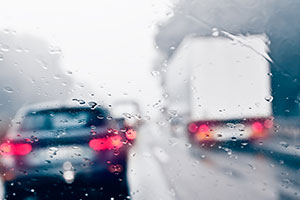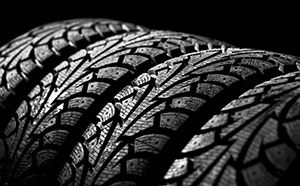Driving In Wet Weather
When it comes to driving in wet weather conditions, it’s essential to take the necessary precautions to ensure your safety on the road. With reduced visibility, slippery roads, and longer braking distances, wet weather driving can be particularly challenging and hazardous. However, by following a few essential tips and preparing your vehicle appropriately, you can minimize the risk of accidents and keep yourself and your passengers safe. In this blog, we’ll discuss some valuable tips for wet weather driving to help you arrive at your destination safely, as well as what happens and what to do if you’re aquaplaning.
Why are road slippery in the first place?
During periods of rain, water can collect on the surface of the road and act as a layer between your tyres and road surface. As a result, your vehicle can lose traction, and this is what is referred to as aquaplaning or hydroplaning. Aquaplaning can be very dangerous, as you have no control over the vehicle. However, we have here some tips on how to avoid this scary experience, and how best to handle it if it does happen to you.
Preparing your vehicle for wet weather
Ensuring your car is set up correctly for rain will go a long way in helping you prevent aquaplaning. Tyres should be inflated to the manufacturer’s recommendations (these can be found in the owner’s manual and often stickered on the doorsill). Under-inflated tyres can increase stopping distances, and cause your vehicle to aquaplane.
Remember that when you’re checking your tyre pressure and inflating your tyres, ensure they are cold (as hot air expands, affecting the reading).
It is also crucial to regularly rotate your tyres and check the condition of the tread. Sufficient tread allows water to be disbursed away from the tyres, increasing grip levels.
If your tread has been worn down, the risk of aquaplaning is significantly higher and you should replace your tyres. Manufacturers include tread wear indicators on the surface of the tyre but, if in doubt, your local tyre specialist will be able to determine if you have sufficient tread.
Tips for Driving On Wet Roads
1. Stay alert on the road.
It’s important to stay alert on the road in wet weather conditions because your reaction time will be slower due to increased braking distances. This means you need to be more attentive and anticipate potential hazards on the road.
2. Pay attention to reaction times
Because your reaction time is slower in wet weather, you need to be even more vigilant and responsive in order to prevent collisions. This means paying closer attention to the road and other drivers, and being prepared to take evasive action if necessary.
3. Increase the distance between yourself and the car in front.
Leaving a larger space means you will have a longer time to react to any collisions ahead. This important in wet weather because it gives you more time to react to any collisions or hazards that may occur. By leaving a larger space, you can increase your margin of safety and reduce your risk of being involved in a crash.
4. Reduce your speed on wet weather roads.
There is no legal requirement for this but Mobile Tyre Shop recommends using best judgement in wet conditions. This is because wet roads can be slippery and unpredictable, and you may need more time to stop or avoid hazards. Use your best judgement and adjust your speed accordingly.
5. Invest in quality tyres
Braking distance can be up to 30% longer than when in wet weather conditions, having a lower tread tyre can increase this even more. It is important to check your cars tread to see if it is roadworthy, Mobile Tyre Shop recommends changing your tyres once they reach around 3mm left on their tread. Premium Tyre Brands can also help with stopping distance as seen in our other blog talking about premium brand tyres. If you drive frequently in rainy conditions, investing in good wet weather tyres is a good option.
6. Regular check-ups on headlights and windscreen wipers
Mobile Tyre Shop recommends checking your headlights once a month just to make sure they are still both working. Not being seen in wet weather can lead to a collision. Also make sure your windscreen wipers are in good condition and functioning correctly. Being seen in wet weather is crucial for safety, and these simple maintenance checks can help ensure you are visible to other drivers.
How To Prevent Hydroplaning

Avoid driving through puddles
The risk of aquaplaning is much higher when driving through puddles and standing water, so where possible avoid driving through them. If there are cars around you this may not be possible to be alert and if you need to drive through them, ensure you slow down.
Slow down when it’s raining
We’ve all heard this advice before, and it makes perfect sense. When it’s raining, visibility is reduced and grip levels are significantly lower. By reducing your speed, you will be more able to react to changes in the road conditions and any puddles you need to go through can be done at a much lower speed, reducing the potential for aquaplaning.
Also, the faster you are travelling, the harder it is for your tyres to disburse the water, so slowing down will give you the most grip.
Don’t brake
If you do find your car aquaplaning, the most important thing is not to panic. Maintaining focus will ensure you are able to react accordingly. Most people will immediately slam on the brakes if traction is lost, but this could send your vehicle into a skid. Instead of braking, ease off the accelerator smoothly to wash off excess speed and regain control of the vehicle.
Don’t make any sudden movements
Maintaining control is important, and sudden movements such as braking, turning or accelerating can exacerbate the problem.
Try to remain as smooth as possible with your inputs, and the car should settle and regain traction accordingly. It’s important not to try and swerve, as this can upset the balance of the car and also cause an accident with surrounding traffic.
Don’t steer into the slide
Aquaplaning is not the same as sliding, so don’t be tempted to steer your vehicle into the slide. Instead, you should focus on an empty and safe place to stop, and smoothly steer and accelerate towards it. If you’re in a rear-wheel drive vehicle, you may want to smoothly back off the accelerator while steering towards the safe space.
By ensuring your vehicle is set up correctly and by driving defensively, you will maximise your chances of avoiding a situation of aquaplaning. However, if you do find yourself in this situation, remaining calm and following these tips will allow you to effectively regain control of your vehicle.
Looking for the best wet weather tyres in Australia?

In conclusion, driving in wet weather conditions can be challenging and dangerous, but there are precautions you can take to stay safe. Ensuring your vehicle’s tyres are in good condition and driving at a safe speed are two of the most important things you can do. With Mobile Tyre Shop’s mobile tyre replacement services, you can conveniently and quickly replace your worn-out tyres, reducing the risk of accidents and keeping you and your passengers safe on the road. Shop tyres here today!
To know more contact us or call Mobile Tyre Shop on 1300 687 000
Driving In Wet Weather
When it comes to driving in wet weather conditions, it’s essential to take the necessary precautions to ensure your safety on the road. With reduced visibility, slippery roads, and longer braking distances, wet weather driving can be particularly challenging and hazardous. However, by following a few essential tips and preparing your vehicle appropriately, you can minimize the risk of accidents and keep yourself and your passengers safe. In this blog, we’ll discuss some valuable tips for wet weather driving to help you arrive at your destination safely, as well as what happens and what to do if you’re aquaplaning.
Why are road slippery in the first place?
During periods of rain, water can collect on the surface of the road and act as a layer between your tyres and road surface. As a result, your vehicle can lose traction, and this is what is referred to as aquaplaning or hydroplaning. Aquaplaning can be very dangerous, as you have no control over the vehicle. However, we have here some tips on how to avoid this scary experience, and how best to handle it if it does happen to you.
Preparing your vehicle for wet weather
Ensuring your car is set up correctly for rain will go a long way in helping you prevent aquaplaning. Tyres should be inflated to the manufacturer’s recommendations (these can be found in the owner’s manual and often stickered on the doorsill). Under-inflated tyres can increase stopping distances, and cause your vehicle to aquaplane.
Remember that when you’re checking your tyre pressure and inflating your tyres, ensure they are cold (as hot air expands, affecting the reading).
It is also crucial to regularly rotate your tyres and check the condition of the tread. Sufficient tread allows water to be disbursed away from the tyres, increasing grip levels.
If your tread has been worn down, the risk of aquaplaning is significantly higher and you should replace your tyres. Manufacturers include tread wear indicators on the surface of the tyre but, if in doubt, your local tyre specialist will be able to determine if you have sufficient tread.
Tips for Driving On Wet Roads
1. Stay alert on the road.
It’s important to stay alert on the road in wet weather conditions because your reaction time will be slower due to increased braking distances. This means you need to be more attentive and anticipate potential hazards on the road.
2. Pay attention to reaction times
Because your reaction time is slower in wet weather, you need to be even more vigilant and responsive in order to prevent collisions. This means paying closer attention to the road and other drivers, and being prepared to take evasive action if necessary.
3. Increase the distance between yourself and the car in front.
Leaving a larger space means you will have a longer time to react to any collisions ahead. This important in wet weather because it gives you more time to react to any collisions or hazards that may occur. By leaving a larger space, you can increase your margin of safety and reduce your risk of being involved in a crash.
4. Reduce your speed on wet weather roads.
There is no legal requirement for this but Mobile Tyre Shop recommends using best judgement in wet conditions. This is because wet roads can be slippery and unpredictable, and you may need more time to stop or avoid hazards. Use your best judgement and adjust your speed accordingly.
5. Invest in quality tyres
Braking distance can be up to 30% longer than when in wet weather conditions, having a lower tread tyre can increase this even more. It is important to check your cars tread to see if it is roadworthy, Mobile Tyre Shop recommends changing your tyres once they reach around 3mm left on their tread. Premium Tyre Brands can also help with stopping distance as seen in our other blog talking about premium brand tyres. If you drive frequently in rainy conditions, investing in good wet weather tyres is a good option.
6. Regular check-ups on headlights and windscreen wipers
Mobile Tyre Shop recommends checking your headlights once a month just to make sure they are still both working. Not being seen in wet weather can lead to a collision. Also make sure your windscreen wipers are in good condition and functioning correctly. Being seen in wet weather is crucial for safety, and these simple maintenance checks can help ensure you are visible to other drivers.
How To Prevent Hydroplaning

Avoid driving through puddles
The risk of aquaplaning is much higher when driving through puddles and standing water, so where possible avoid driving through them. If there are cars around you this may not be possible to be alert and if you need to drive through them, ensure you slow down.
Slow down when it’s raining
We’ve all heard this advice before, and it makes perfect sense. When it’s raining, visibility is reduced and grip levels are significantly lower. By reducing your speed, you will be more able to react to changes in the road conditions and any puddles you need to go through can be done at a much lower speed, reducing the potential for aquaplaning.
Also, the faster you are travelling, the harder it is for your tyres to disburse the water, so slowing down will give you the most grip.
Don’t brake
If you do find your car aquaplaning, the most important thing is not to panic. Maintaining focus will ensure you are able to react accordingly. Most people will immediately slam on the brakes if traction is lost, but this could send your vehicle into a skid. Instead of braking, ease off the accelerator smoothly to wash off excess speed and regain control of the vehicle.
Don’t make any sudden movements
Maintaining control is important, and sudden movements such as braking, turning or accelerating can exacerbate the problem.
Try to remain as smooth as possible with your inputs, and the car should settle and regain traction accordingly. It’s important not to try and swerve, as this can upset the balance of the car and also cause an accident with surrounding traffic.
Don’t steer into the slide
Aquaplaning is not the same as sliding, so don’t be tempted to steer your vehicle into the slide. Instead, you should focus on an empty and safe place to stop, and smoothly steer and accelerate towards it. If you’re in a rear-wheel drive vehicle, you may want to smoothly back off the accelerator while steering towards the safe space.
By ensuring your vehicle is set up correctly and by driving defensively, you will maximise your chances of avoiding a situation of aquaplaning. However, if you do find yourself in this situation, remaining calm and following these tips will allow you to effectively regain control of your vehicle.
Looking for the best wet weather tyres in Australia?

In conclusion, driving in wet weather conditions can be challenging and dangerous, but there are precautions you can take to stay safe. Ensuring your vehicle’s tyres are in good condition and driving at a safe speed are two of the most important things you can do. With Mobile Tyre Shop’s mobile tyre replacement services, you can conveniently and quickly replace your worn-out tyres, reducing the risk of accidents and keeping you and your passengers safe on the road. Shop tyres here today!
To know more contact us or call Mobile Tyre Shop on 1300 687 000



